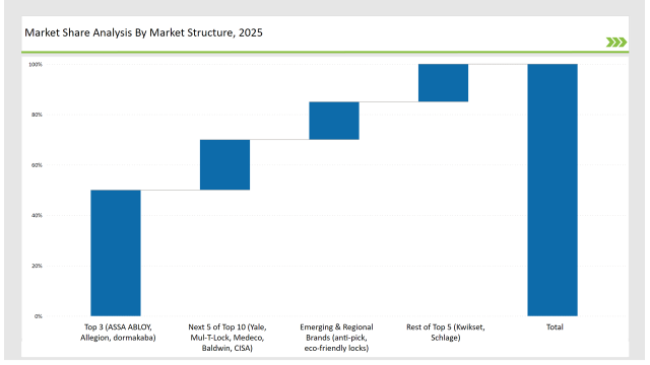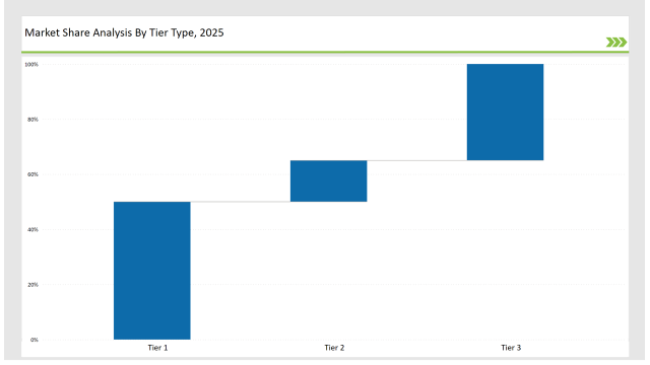The mechanical locks market is experiencing steady demand as security-conscious consumers and businesses continue to prioritize durable, key-based security solutions. Despite the rise of digital and smart locks, mechanical locks remain a preferred choice due to their reliability, affordability, and resistance to cyber threats.
Companies focusing on high-quality materials, tamper-resistant designs, and innovative locking mechanisms are leading the industry. Leading brands such as ASSA ABLOY, Allegion, and dormakaba collectively hold 50% of the market share, leveraging strong security standards, extensive product portfolios, and global distribution networks.
Independent and regional manufacturers account for 30%, offering cost-effective, niche, and specialty locks. Meanwhile, emerging startups focusing on high-security, anti-pick technology, and eco-friendly lock manufacturing contribute 20% to the market.
Explore FMI!
Book a free demo
| Market Segment | Industry Share (%) |
|---|---|
| Top 3 (ASSA ABLOY, Allegion, dormakaba) | 50% |
| Rest of Top 5 (Kwikset, Schlage) | 15% |
| Next 5 of Top 10 (Yale, Mul-T-Lock, Medeco, Baldwin, CISA) | 20% |
| Emerging & Regional Brands (anti-pick, eco-friendly locks) | 15% |

| Market Concentration | Assessment |
|---|---|
| High (More than 60% by top players) | Medium |
| Medium (40 to 60% by top 10 players) | High |
| Low (Less than 30% by top players) | Low |
Dominating the market with 50% are Retail & Hardware Stores, as consumers prefer in-person lock selection and installation guidance. Following this is 30% E-commerce & Direct-to-Consumer Sales, because of the DIY home improvement trends and online convenience. Taking up the remaining 15% are B2B & Commercial Lock Suppliers, catering to businesses, institutions, and government facilities. Lastly, High-Security & Custom Lock Manufacturing at 5%, destined for specialized security needs.
Deadbolts & Cylinder Locks lead with 40%, ensuring high security for residential and commercial buildings. Padlocks & Keyed Entry Locks represent 30%, providing portable and versatile security solutions. Mortise & Lever Handle Locks account for 20%, commonly used in high-traffic and commercial applications. High-Security & Anti-Pick Mechanical Locks make up 10%, offering tamper-resistant solutions for critical security applications.
As customer preferences evolved, market leaders and new entrants made strategic choices that transformed the mechanical locks industry.

| Tier Type | Tier 1 |
|---|---|
| Example of Key Players | ASSA ABLOY, Allegion, dormakaba |
| Market Share (%) | 50% |
| Tier Type | Tier 2 |
|---|---|
| Example of Key Players | Kwikset, Schlage |
| Market Share (%) | 15% |
| Tier Type | Tier 3 |
|---|---|
| Example of Key Players | Yale, Mul-T-Lock, Medeco, Baldwin, CISA |
| Market Share (%) | 35% |
| Brand | Key Focus Areas |
|---|---|
| ASSA ABLOY | Tamper-proof & fire-rated mechanical locks |
| Allegion | Key control systems & durable high-traffic locks |
| dormakaba | Anti-pick technology & commercial-grade locks |
| Kwikset | Keyless mechanical solutions & security innovations |
| Emerging Brands | Reinforced deadbolts & eco-friendly locking materials |
The mechanical locks market is transforming towards more secure, durable, and sustainable solutions. Brands that have anti-pick features, high-quality materials, and innovative key control systems will be at the forefront of the industry. Tamper-resistant and hybrid mechanical-smart locks are also changing consumer expectations. Eco-friendly manufacturing and high-security lock technologies will become the norm of the day.
More businesses and householders will opt for the more robust locking solutions that meet traditional security alongside modern convenience. In addition, key management solutions incorporating companies that are sustainable and care for the environment will stand to benefit over the long term. In this respect, the future of the mechanical locks market shall be a much stronger and safer market that shall be defined by evolving security requirements.
Leading players such as ASSA ABLOY, Allegion, and dormakaba collectively hold around 50% of the market.
Online and retail store sales represent approximately 30% of the market, driven by DIY security installations.
These solutions account for about 10% of the market, with projected growth in security-sensitive applications.
Green and recyclable mechanical locks hold around 15% of the market, with increasing consumer demand.
High for companies controlling 50%+, medium for 30% to 50%, and low for those under 30%.
POU Water Purifier Industry Analysis In MENA: Trends, Growth & Forecast 2025 to 2035
Coffea Arabica (Coffee) Seed Oil Market - Trends, Growth & Forecast 2025 to 2035
Dog Collars, Leashes & Harnesses Market Analysis by Dog Collars, Dog Leash, Dog Harness, Material Type, Distribution Channel and Region Through 2025 to 2035.
Cat Toys Market Analysis by Product Type, Material Type, Sales Channel, End-User, Application and Region Through 2035
Baby Swing Market Analysis by Seat Type, Sales Channel, End User, and Region, Forecast through 2035
Anti-Pollution Hair Care Market Analysis by Product Type, Packaging Type, and Region - Trends, Growth & Forecast 2025 to 2035

Thank you!
You will receive an email from our Business Development Manager. Please be sure to check your SPAM/JUNK folder too.